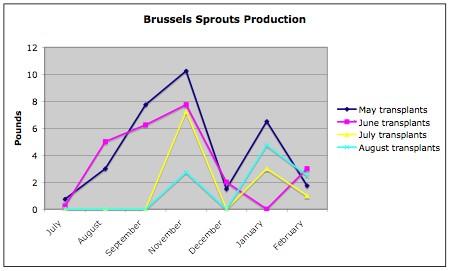Brussels Sprouts 2006 Trial
Garden Help > Vegetables > Brussels Sprouts
Summary
For best Brussels sprouts production, transplant seedlings into the garden in May or June. The plants will begin to produce sprouts in the summer and will continue through the fall and winter.
Overview
The purpose of the project was to determine the best timing for planting Brussels sprouts in Santa Clara County’s unique climate.
September and October are the recommended months for transplanting cabbage family plants such as broccoli, cauliflower, and cabbage. But Brussels sprouts that are transplanted then often don’t produce well. We wondered if starting the plants earlier in the summer would yield better results. We started seeds one month apart from May to August and tracked the results.
Soil preparation
The plot was cover cropped with fava beans which were cut down and rototilled into the beds in April, along with some aged horse manure.
Seeding/planting
We started five sets of seedlings of Jade Cross Brussels sprouts (seeds from Stokes) approximately one month apart throughout the spring and summer. We transplanted the strongest six seedlings from each batch when they were about six weeks old—planted one foot apart, in two rows one foot apart, in a three-foot wide bed. Each seedling had a handful of alfalfa pellets dug into its hole before planting.
| Started 8 seeds | Transplanted strongest 4 | First Harvest | Last Harvest |
|---|---|---|---|
| April 5 | May 17 | July 26 | February 14 |
| May 4 | June 14 | July 26 | February 14 |
| June 7 | July 19 | November 1 | February 14 |
| July 5 | August 16 (replanted August 23) | November 22 | February 14 |
| August 2 | September 13 | Never | Never |
The August transplants were disrupted by some unknown creature, so they had to be replanted. The August seedlings did not germinate or grow very well, possibly due to the hot weather at that point. When they were transplanted in September, they didn’t thrive and never produced any sprouts.
Watering
Plants were on drip irrigation which ran 3 times a week for 1 hour each time.
Fertilization
No fertilizer other than compost and alfalfa pellets was used.
Harvesting
The May and June plantings began producing sprouts by the end of July and continued through February. Even by the end, they were generally more productive than the July and August transplants, as can be seen in Figure 1.

The following table shows the total production for the season for each set of transplants. The May and June transplants were clearly the most productive.
| Month Transplanted | Total Pounds |
|---|---|
| May | 31.5 |
| June | 24.25 |
| July | 11.25 |
| August | 10 |
Tasting
Tasting was done at home by volunteers. The summer harvests were edible but without much flavor. When combined with other ingredients, they made a fine and presumably healthy dish even though they lacked the distinctive Brussels sprouts flavor. We were surprised and pleased that they didn’t exhibit a strong, sulfurous flavor since they matured in the heat of the summer.
As the months progressed, the sprouts gained more flavor and sweetness, although some tasters felt they never achieved the sweetness that the best of Brussels sprouts exhibit. Perhaps this was due to the variety used.
Pests and diseases
Seedlings were sprayed with Bt (Bacillus thuringiensis) while young to prevent damage from cabbage worms. In July and August, several plants had aphid infestations. We treated them by spraying as many of the aphids off with water as we could, then spraying with an insecticidal soap to get the ones that were hiding in cracks and crevices where we couldn’t dislodge them.
Summary
For best Brussels sprouts production, transplant seedlings into the garden in May or June. The plants will begin to produce sprouts in the summer and will continue through the fall and winter.
Lead: Karen Schaffer
Thanks: to the entire team for their assistance, especially in the bed preparation. Special thanks to Jeannie Sunseri, Sally Pyle, and Mike Kent for their assistance throughout the project, and big thanks to Mae Schrank for hours of harvesting.






